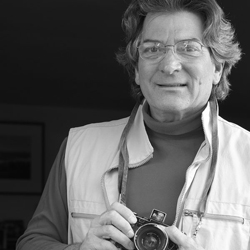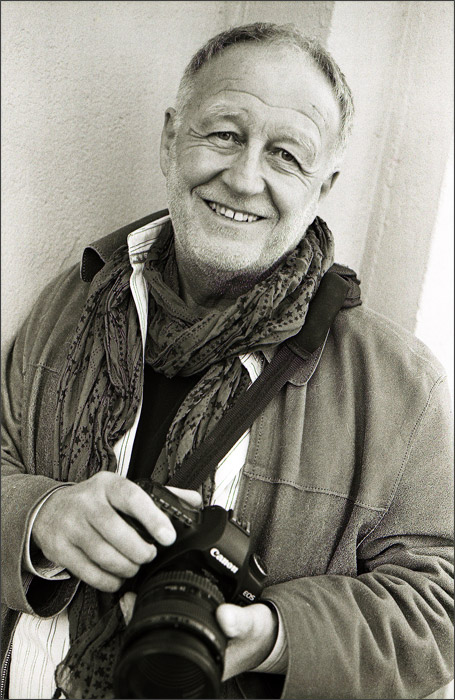 On April 26, 1986, the nuclear power plant at Chernobyl in Ukraine became the sight of the worst nuclear accident in history.
Authorities waited 36 hours after the explosion to begin the evacuation of 336,000 people. 135,000 were permanently relocated. Nuclear radiation was released into the environment and blew across Europe. Hundreds of first responders died of Acute Radiation Sickness. Following the disaster, workers known as "liquidators" commenced cleanup activities under extremely hazardous conditions. It is estimated that 800,000 people were thus employed, with untold affects on the liquidators and their families for generations to come. It is impossible to estimate the number of people who have been affected by the disaster accurately. Attempting to minimize the magnitude of the disaster, the former Soviet Union did not release accurate statistics.
A direct link between the toxic plume, air, ground, water and food contamination and years later, the affect on the population is difficult to establish. Thousands have been affected with thyroid cancer, genetic abnormalities and other known affects of radiation.
After the disaster, the contaminated areas were isolated and sealed off into the "zone of alienation," carefully controlled areas where there remain dangerous levels of radiation. These abandoned ghost towns, complete with personal belongings, are now overcome by nature. They have seen the return of many native species that survived the fallout and now flourish in an area free of human habitation.
Gerd Ludwig is a photojournalist with an extensive body of work documenting social changes in Germany and Eastern Europe after the collapse of the Soviet Union and 20 years working for National Geographic magazine. His work includes this long-term project on the aftermath of the Chernobyl Nuclear Power Plant disaster. He is gearing up for another trip to the zone of alienation to coincide with the 25th Anniversary of the Chernobyl disaster.
On April 26, 1986, the nuclear power plant at Chernobyl in Ukraine became the sight of the worst nuclear accident in history.
Authorities waited 36 hours after the explosion to begin the evacuation of 336,000 people. 135,000 were permanently relocated. Nuclear radiation was released into the environment and blew across Europe. Hundreds of first responders died of Acute Radiation Sickness. Following the disaster, workers known as "liquidators" commenced cleanup activities under extremely hazardous conditions. It is estimated that 800,000 people were thus employed, with untold affects on the liquidators and their families for generations to come. It is impossible to estimate the number of people who have been affected by the disaster accurately. Attempting to minimize the magnitude of the disaster, the former Soviet Union did not release accurate statistics.
A direct link between the toxic plume, air, ground, water and food contamination and years later, the affect on the population is difficult to establish. Thousands have been affected with thyroid cancer, genetic abnormalities and other known affects of radiation.
After the disaster, the contaminated areas were isolated and sealed off into the "zone of alienation," carefully controlled areas where there remain dangerous levels of radiation. These abandoned ghost towns, complete with personal belongings, are now overcome by nature. They have seen the return of many native species that survived the fallout and now flourish in an area free of human habitation.
Gerd Ludwig is a photojournalist with an extensive body of work documenting social changes in Germany and Eastern Europe after the collapse of the Soviet Union and 20 years working for National Geographic magazine. His work includes this long-term project on the aftermath of the Chernobyl Nuclear Power Plant disaster. He is gearing up for another trip to the zone of alienation to coincide with the 25th Anniversary of the Chernobyl disaster.
AF: I usually begin my interviews by asking my subjects how they got started in photography. When did you start photographing? How old were you? I know you were not a native to America: what country are you from? What was your first camera? GL: I'm a small town boy. I was born near Frankfurt, Germany and I went to high school in that town. Subsequently, I studied political science, German literature and physical education. After three terms I quit. The people I studied physical education with were not intellectual enough and in political science and German literature they were only intellectual. Together with a friend I traveled for one year, doing odd jobs, as a dishwasher, a gardener, bricklayer, and even a sailor. I went to Scandinavia first, then on a Norwegian boat to the US. While traveling, I was looking for new subjects to study: possibly sociology, psychology and all the hip subjects of the late 60's and early 70's. During my travels I wanted to convey something from my experiences, to take back impressions from the countries I visited. I didn't have enough money to buy souvenirs, so I bought a camera. I took snapshots to preserve memories of those travel days. As I wanted to improve my images, I started to buy photo magazines. That was when I realized photography could be a very educational tool, conveying a personal point of view. Because I had a great deal of fun taking pictures, I decided to study photography. AF: Did you work originally with black and white film? Or were you shooting color? GL: Yes, it was black and white film. My first camera was a real amateur camera, a Voightlander. Unfortunately, I don't have it anymore. I had my photos processed in the local photo shops. I returned to Germany and, after an internship at a portrait studio, I was lucky enough to get accepted into what was then the best school for photography in Germany, if not for all of Europe, with professor Otto Steinert at the Folkwang University of the Arts in Essen, Germany. The University taught visual arts, music and theatre arts and ballet, all under one roof. It was a very exciting place to study! [caption id="attachment_2044" align="aligncenter" width="590"]
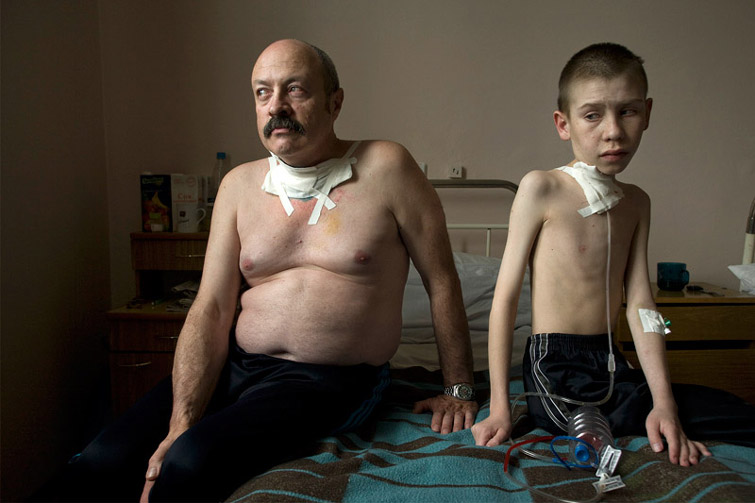 Suffering from thyroid cancer, Oleg S., 54, and Dima B., 13, receive care at a thyroid hospital in Belarus, where surgery is performed on a daily basis. As a liquidator, Oleg was exposed to extreme levels of radiation when razing contaminated houses near the destroyed reactor. This was his third thyroid operation. Dima's mother claims that Chernobyl's nuclear fallout is responsible for his cancer, but his doctors are more cautious: Belarusian officials are ordered to downplay the severity of the nuclear after-effects as the country is eager to start re-cultivating huge areas of contaminated fallow land. The Long Shadow of Chernobyl - Photographs © Gerd Ludwig/INSTITUTE[/caption]
AF: I want to focus on the Chernobyl project that you have dedicated yourself to with such passion. I know your career is extensive, but because of the nature of the Chernobyl project and what you are hoping to accomplish there in the near future, I would like to focus on that.
Tell me briefly, if you can, what was the origin of the Chernobyl project? We know that the horrific accident happened in April of 1986, correct? Explain in your own words the beginning of the project, so our audience has a sense of where all of this started.
[caption id="attachment_2046" align="alignleft" width="250"]
Suffering from thyroid cancer, Oleg S., 54, and Dima B., 13, receive care at a thyroid hospital in Belarus, where surgery is performed on a daily basis. As a liquidator, Oleg was exposed to extreme levels of radiation when razing contaminated houses near the destroyed reactor. This was his third thyroid operation. Dima's mother claims that Chernobyl's nuclear fallout is responsible for his cancer, but his doctors are more cautious: Belarusian officials are ordered to downplay the severity of the nuclear after-effects as the country is eager to start re-cultivating huge areas of contaminated fallow land. The Long Shadow of Chernobyl - Photographs © Gerd Ludwig/INSTITUTE[/caption]
AF: I want to focus on the Chernobyl project that you have dedicated yourself to with such passion. I know your career is extensive, but because of the nature of the Chernobyl project and what you are hoping to accomplish there in the near future, I would like to focus on that.
Tell me briefly, if you can, what was the origin of the Chernobyl project? We know that the horrific accident happened in April of 1986, correct? Explain in your own words the beginning of the project, so our audience has a sense of where all of this started.
[caption id="attachment_2046" align="alignleft" width="250"]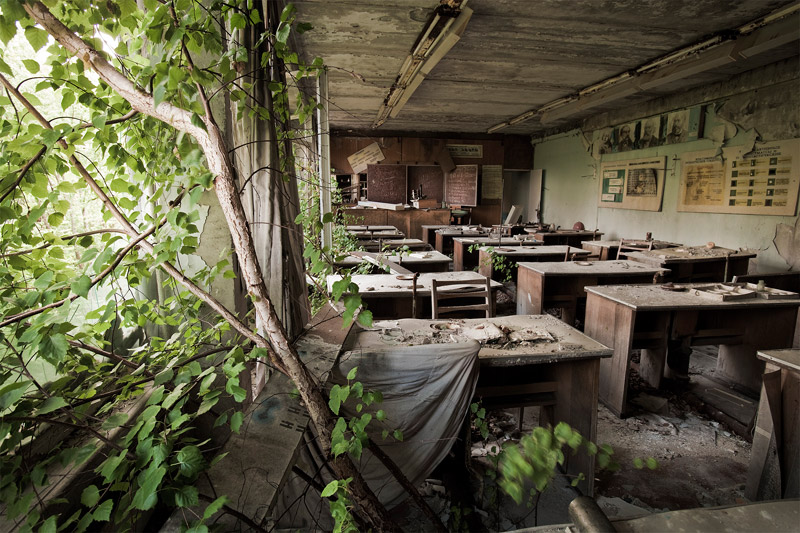 Twenty-five years later, the empty schoolrooms of Pripyat stand as a testament to the sudden and tragic departure of the city's residents. As nature takes over the abandoned buildings and homes inside the Exclusion Zone, it is a stark contrast to the fear-plagued lives of the people who survived the world's worst nuclear accident. The Long Shadow of Chernobyl - Photographs © Gerd Ludwig/INSTITUTE[/caption]
GL: Four weeks after the event, I learned about the catastrophe while on assignment in a small town in Newfoundland, Canada with no television in the hotel room. I immediately called my friends and family in Germany. At that point some of my male friends had already evacuated their children and pregnant wives to Holland. Only then did I really begin to understand that all of Europe felt threatened from the accident. That's when the magnitude of the accident really hit me.
I first went to the Chernobyl zone on assignment for National Geographic magazine several years later.
AF: What year was it?
GL: First in 1993, for an extended period of time, I visited the thirty-kilometer zone, which is a fenced-in area with controlled access in and out.
AF: Is that a radius of 30 kilometers? Like a very big circle? That would be a large area of land.
[caption id="attachment_2040" align="alignright" width="250"]
Twenty-five years later, the empty schoolrooms of Pripyat stand as a testament to the sudden and tragic departure of the city's residents. As nature takes over the abandoned buildings and homes inside the Exclusion Zone, it is a stark contrast to the fear-plagued lives of the people who survived the world's worst nuclear accident. The Long Shadow of Chernobyl - Photographs © Gerd Ludwig/INSTITUTE[/caption]
GL: Four weeks after the event, I learned about the catastrophe while on assignment in a small town in Newfoundland, Canada with no television in the hotel room. I immediately called my friends and family in Germany. At that point some of my male friends had already evacuated their children and pregnant wives to Holland. Only then did I really begin to understand that all of Europe felt threatened from the accident. That's when the magnitude of the accident really hit me.
I first went to the Chernobyl zone on assignment for National Geographic magazine several years later.
AF: What year was it?
GL: First in 1993, for an extended period of time, I visited the thirty-kilometer zone, which is a fenced-in area with controlled access in and out.
AF: Is that a radius of 30 kilometers? Like a very big circle? That would be a large area of land.
[caption id="attachment_2040" align="alignright" width="250"]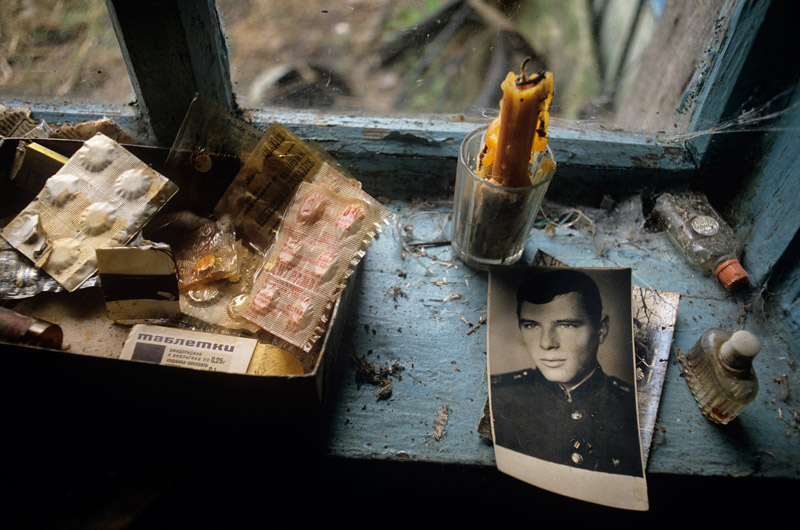 When Soviet authorities finally order the evacuation of the nearly 150 villages within a 19-mile radius of the power plant to evacuate, the hasty departure often meant leaving behind the most personal belongings. The Soviet Union only admitted to the world that the accident had occurred 3-days after the explosion, when scientists in Sweden noticed radiation on their shoes before entering a nuclear facility. The explosion unleashed radiation around the globe, more than tripling the world's background radiation level. The Long Shadow of Chernobyl - Photographs © Gerd Ludwig/INSTITUTE[/caption]
GL: Yes. It's a huge area. Thousands of square miles were contaminated by the accident, but the government officials drew a 30-kilometer radius and closed the area off. Today we know that it was really an arbitrary radius and that there are areas outside of that zone that are more contaminated than some inside the zone.
AF: Was that because of the radioactive cloud after the incident?
GL: It was related to the rainfall. Research showed that rain washed the radiation out of the air and contaminated the ground.
AF: Do you recall what your very first impressions were? Do you have any memorable, vivid impressions?
GL: It was incredibly controlled. The Ukrainian government watched every move I made (this was after the fall of Russian dominance), and militia accompanied me everywhere I went. While the militia followed their orders on one hand, they accommodated my efforts to receive permission from authorities - who were simply trying to keep us out and far away. At that time, I was not yet allowed to get near the reactor, let alone inside of it. There is a second fence around the reactor because the radiation there is very high near the so-called "sarcophagus."
At some point, I realized that the radiation in the zone was moving. Where the militia had told us, "This is a very safe area, not very highly contaminated," my dosimeter told me something else. Contamination travels as a result of strong winds moving surface soil.
AF: So you actually carried a dosimeter with you??
GL: Oh, sure. I carried a dosimeter and protective gear, as well. I was wearing my own protective suits then. But the authorities asked us (my assistants and interpreters and me) not to wear our protective gear and not to carry Geiger counters and dosimeters because at that point in time, the population didn't have any of these things. They said, "You scare our people by wearing all this protective gear."
As a photographer you walk this fine line; you need their cooperation for access, but you don't want to endanger yourself.
AF: How did you communicate with them? Do you speak Russian at all?
GL: I understand a bit of Russian. My assistant acts as my interpreter most of the time. I always had somebody with me. I have worked with him for more than 20 years now and we have become close friends.
When shooting in the Former Soviet Union, I have two people assisting me. One person is a "fixer" and researcher, who makes appointments for me so that I don't get bogged down with making phone calls myself, sitting by the phone with an interpreter. In the morning my fixer may take examples of my work, like past publications of National Geographic magazine and samples from other assignments I've worked on. The images act as my business card, my entry card, for my subjects or the officials. Then an appointment would be set up for the following day and I would arrive with my interpreter.
AF: You were there in 1993. So I'm curious: were you shooting film then?
GL: Yes.
[caption id="attachment_2045" align="alignleft" width="250"]
When Soviet authorities finally order the evacuation of the nearly 150 villages within a 19-mile radius of the power plant to evacuate, the hasty departure often meant leaving behind the most personal belongings. The Soviet Union only admitted to the world that the accident had occurred 3-days after the explosion, when scientists in Sweden noticed radiation on their shoes before entering a nuclear facility. The explosion unleashed radiation around the globe, more than tripling the world's background radiation level. The Long Shadow of Chernobyl - Photographs © Gerd Ludwig/INSTITUTE[/caption]
GL: Yes. It's a huge area. Thousands of square miles were contaminated by the accident, but the government officials drew a 30-kilometer radius and closed the area off. Today we know that it was really an arbitrary radius and that there are areas outside of that zone that are more contaminated than some inside the zone.
AF: Was that because of the radioactive cloud after the incident?
GL: It was related to the rainfall. Research showed that rain washed the radiation out of the air and contaminated the ground.
AF: Do you recall what your very first impressions were? Do you have any memorable, vivid impressions?
GL: It was incredibly controlled. The Ukrainian government watched every move I made (this was after the fall of Russian dominance), and militia accompanied me everywhere I went. While the militia followed their orders on one hand, they accommodated my efforts to receive permission from authorities - who were simply trying to keep us out and far away. At that time, I was not yet allowed to get near the reactor, let alone inside of it. There is a second fence around the reactor because the radiation there is very high near the so-called "sarcophagus."
At some point, I realized that the radiation in the zone was moving. Where the militia had told us, "This is a very safe area, not very highly contaminated," my dosimeter told me something else. Contamination travels as a result of strong winds moving surface soil.
AF: So you actually carried a dosimeter with you??
GL: Oh, sure. I carried a dosimeter and protective gear, as well. I was wearing my own protective suits then. But the authorities asked us (my assistants and interpreters and me) not to wear our protective gear and not to carry Geiger counters and dosimeters because at that point in time, the population didn't have any of these things. They said, "You scare our people by wearing all this protective gear."
As a photographer you walk this fine line; you need their cooperation for access, but you don't want to endanger yourself.
AF: How did you communicate with them? Do you speak Russian at all?
GL: I understand a bit of Russian. My assistant acts as my interpreter most of the time. I always had somebody with me. I have worked with him for more than 20 years now and we have become close friends.
When shooting in the Former Soviet Union, I have two people assisting me. One person is a "fixer" and researcher, who makes appointments for me so that I don't get bogged down with making phone calls myself, sitting by the phone with an interpreter. In the morning my fixer may take examples of my work, like past publications of National Geographic magazine and samples from other assignments I've worked on. The images act as my business card, my entry card, for my subjects or the officials. Then an appointment would be set up for the following day and I would arrive with my interpreter.
AF: You were there in 1993. So I'm curious: were you shooting film then?
GL: Yes.
[caption id="attachment_2045" align="alignleft" width="250"]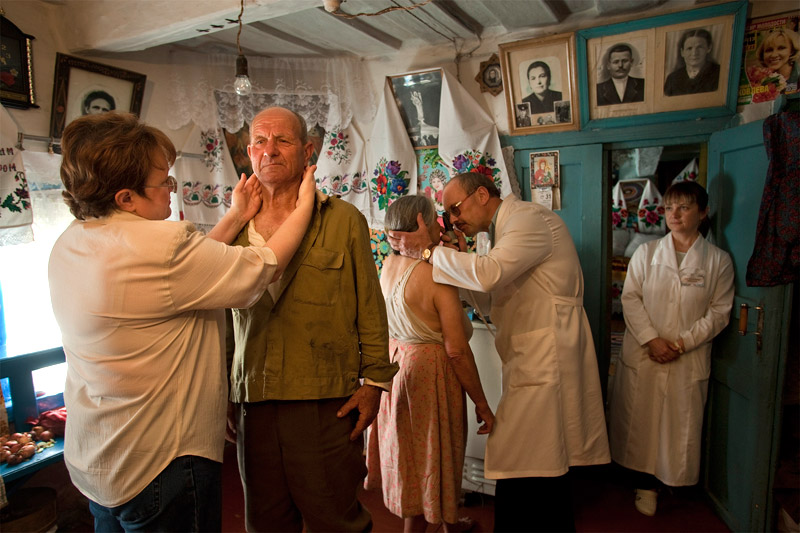 Today, several hundred elderly residents have returned to their village homes, preferring to die on their own contaminated soil, rather than from a broken heart in anonymous city suburbs. Now tolerated, the authorities initially considered the returnees as illegal residents, and chased them from their homes. Generally without means of transportation, none of the few hundred returnees have easy access to medical help. To ensure basic health care, teams of doctors from the Chernobyl hospital make their rounds to the few inhabited villages each month. The Long Shadow of Chernobyl - Photographs © Gerd Ludwig/INSTITUTE[/caption]
AF: Was there any concern about the radioactivity affecting your film?
GL: No. In 1993 I wasn't allowed to go that deep into the reactor and the camera does shield the film. Nobody would be allowed to be that long and close inside the highly contaminated areas anyway. It would be fatal.
AF: So were you shooting color transparency? Did you also use any black and white film?
GL: No. I was shooting color transparency exclusively. When I shot for National Geographic I did not shoot high-speed film because it isn't up to the quality standards of reproduction National Geographic maintains on their pages.
I went back in 2005 for an extended period of time and I was granted access deep inside of the reactor, very close to where the explosion occurred. There, the workers, despite wearing many layers of protective gear and gas masks, were only allowed to enter for one shift of 15 minutes a day.
AF: What is the shelf life of this horrific accident?
GL: There are different stages of contamination; the core is contaminated for untold years to come.
[caption id="attachment_2043" align="alignright" width="250"]
Today, several hundred elderly residents have returned to their village homes, preferring to die on their own contaminated soil, rather than from a broken heart in anonymous city suburbs. Now tolerated, the authorities initially considered the returnees as illegal residents, and chased them from their homes. Generally without means of transportation, none of the few hundred returnees have easy access to medical help. To ensure basic health care, teams of doctors from the Chernobyl hospital make their rounds to the few inhabited villages each month. The Long Shadow of Chernobyl - Photographs © Gerd Ludwig/INSTITUTE[/caption]
AF: Was there any concern about the radioactivity affecting your film?
GL: No. In 1993 I wasn't allowed to go that deep into the reactor and the camera does shield the film. Nobody would be allowed to be that long and close inside the highly contaminated areas anyway. It would be fatal.
AF: So were you shooting color transparency? Did you also use any black and white film?
GL: No. I was shooting color transparency exclusively. When I shot for National Geographic I did not shoot high-speed film because it isn't up to the quality standards of reproduction National Geographic maintains on their pages.
I went back in 2005 for an extended period of time and I was granted access deep inside of the reactor, very close to where the explosion occurred. There, the workers, despite wearing many layers of protective gear and gas masks, were only allowed to enter for one shift of 15 minutes a day.
AF: What is the shelf life of this horrific accident?
GL: There are different stages of contamination; the core is contaminated for untold years to come.
[caption id="attachment_2043" align="alignright" width="250"]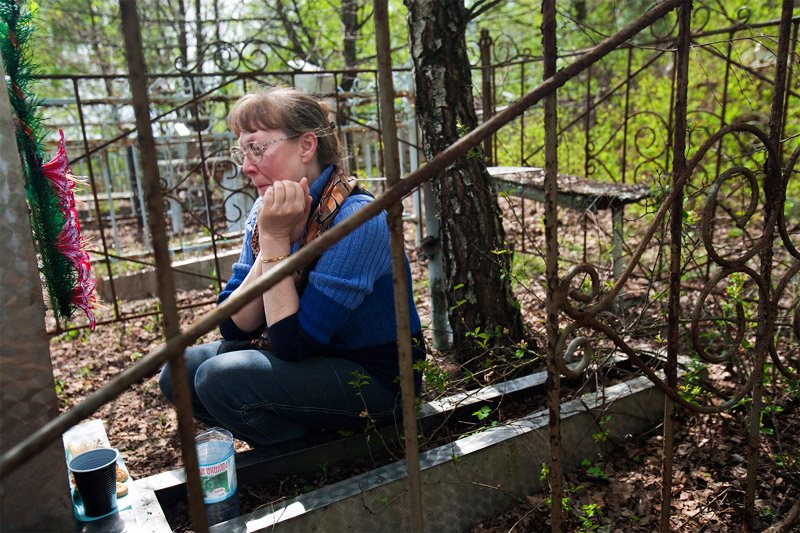 This is only the second time since being forced to evacuate in 1986 that Ludmila S., 55, is able to visit her former hometown of Pripyat. She mourns at the grave of her parents and begs for their forgiveness for her long involuntary absence. The Long Shadow of Chernobyl - Photographs © Gerd Ludwig/INSTITUTE[/caption]
AF: Meaning that human beings are extremely vulnerable if they get near these contaminated zones?
GL: Yes.
AF: Can you explain what radiation actually does to the human body to destroy it?
GL: Radiation that was released in the Chernobyl zone was not from only one isotope; there were different types of radiation. Scientists still argue over the damage that radiation can do, but there is no dispute about the affects on the thyroid gland. There has been a huge rise in thyroid cancer.
I met people who were there at the time of the reactor accident. One of them had burns all over his body. A tragic situation: Working as a security guard in the reactor, in the chaotic hours following the explosion, he found a colleague who had fainted, lying in the contaminated water. He carried him out on his back. Soon skin burns formed where the contaminated water from his friend's body had seeped through his clothing and, as a result of walking through the contaminated water, he had one leg amputated. All his efforts were in vain. His friend did not make it. There were so many tragedies.
AF: When did you first encounter the victims directly from the accident?
GL: It was in 1993, and again in 2005.
AF: When did it really hit you, the human suffering from this horrible event?
GL: You see it when you're inside the zone. A total of 336,000 people had been relocated to different areas after the accident.
Shortly thereafter, even within the first year, a few of the elderly citizens started to return to the contaminated zone illegally. Between 400 and 700 people returned to the zone, living isolated in a few small villages, with total devastation surrounding them.
AF: Why did they choose to go back? It seems like suicide to expose themselves to the contamination. Were they clearly aware of the risks involved?
GL: Yes, they understood the risks involved. It was mostly the elderly who wanted to live out their lives on their own soil, rather than dying of a broken heart, in anonymous city suburbs. They even started to grow vegetables in their contaminated earth. They said, "That's were we were born, that's were we want to die."
AF: You photographed these people?
GL: Yes. These are often broken lives.
AF: Did the Ukrainian government compensate them in any way?
GL: I don't know. In the beginning the government called them illegal residents, even started to hunt them down. But later they began to tolerate the practice of their returning. There are no private cars in the zone and no public transportation. But the returnees demanded some type of infrastructure; they asked for doctors and for necessities such as soap, for example.
[caption id="attachment_2042" align="alignleft" width="250"]
This is only the second time since being forced to evacuate in 1986 that Ludmila S., 55, is able to visit her former hometown of Pripyat. She mourns at the grave of her parents and begs for their forgiveness for her long involuntary absence. The Long Shadow of Chernobyl - Photographs © Gerd Ludwig/INSTITUTE[/caption]
AF: Meaning that human beings are extremely vulnerable if they get near these contaminated zones?
GL: Yes.
AF: Can you explain what radiation actually does to the human body to destroy it?
GL: Radiation that was released in the Chernobyl zone was not from only one isotope; there were different types of radiation. Scientists still argue over the damage that radiation can do, but there is no dispute about the affects on the thyroid gland. There has been a huge rise in thyroid cancer.
I met people who were there at the time of the reactor accident. One of them had burns all over his body. A tragic situation: Working as a security guard in the reactor, in the chaotic hours following the explosion, he found a colleague who had fainted, lying in the contaminated water. He carried him out on his back. Soon skin burns formed where the contaminated water from his friend's body had seeped through his clothing and, as a result of walking through the contaminated water, he had one leg amputated. All his efforts were in vain. His friend did not make it. There were so many tragedies.
AF: When did you first encounter the victims directly from the accident?
GL: It was in 1993, and again in 2005.
AF: When did it really hit you, the human suffering from this horrible event?
GL: You see it when you're inside the zone. A total of 336,000 people had been relocated to different areas after the accident.
Shortly thereafter, even within the first year, a few of the elderly citizens started to return to the contaminated zone illegally. Between 400 and 700 people returned to the zone, living isolated in a few small villages, with total devastation surrounding them.
AF: Why did they choose to go back? It seems like suicide to expose themselves to the contamination. Were they clearly aware of the risks involved?
GL: Yes, they understood the risks involved. It was mostly the elderly who wanted to live out their lives on their own soil, rather than dying of a broken heart, in anonymous city suburbs. They even started to grow vegetables in their contaminated earth. They said, "That's were we were born, that's were we want to die."
AF: You photographed these people?
GL: Yes. These are often broken lives.
AF: Did the Ukrainian government compensate them in any way?
GL: I don't know. In the beginning the government called them illegal residents, even started to hunt them down. But later they began to tolerate the practice of their returning. There are no private cars in the zone and no public transportation. But the returnees demanded some type of infrastructure; they asked for doctors and for necessities such as soap, for example.
[caption id="attachment_2042" align="alignleft" width="250"]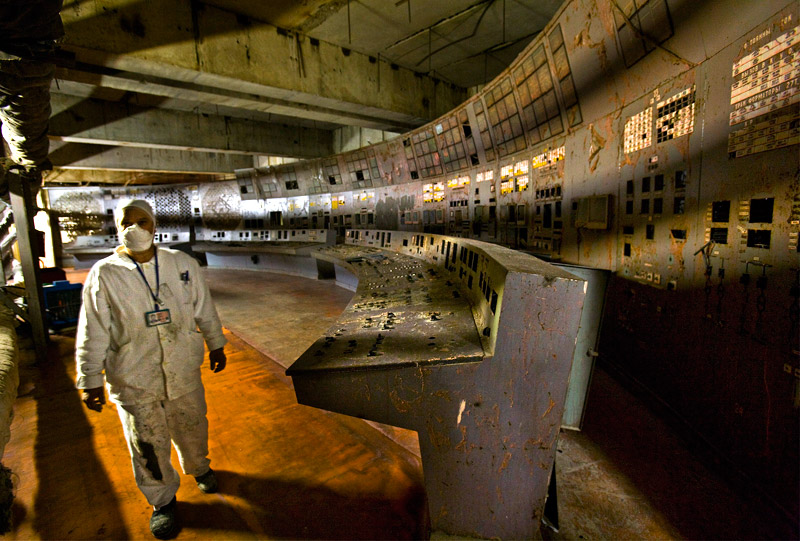 At 1:23 am on April 26, 1986, the Chernobyl Nuclear Power Plant operators committed a fatal series of errors here in the control room of Reactor #4, triggering a meltdown and an explosion that resulted in the world's largest nuclear accident to date. The Long Shadow of Chernobyl - Photographs © Gerd Ludwig/INSTITUTE[/caption]
AF: How did they exist? How did they get food? Plumbing?
GL: They wanted delivery of food items they could not grow, or household tools. The administration helped them reluctantly, because it put such service and delivery people at risk. Now a few clever business people drive - with permission from the authorities - to where the returnees live in scattered, contaminated villages, and sell them goods they need for their survival in isolation.
AF: I have a personal question for you. Emotionally, the risk that you take in subjecting yourself to this story (which is almost out of a science fiction novel really, although it isn't) the despair and the result, and even the visual of it, understanding the suffering that has occurred because of it, the true human horror of it all . . . How do you preserve your own sense of tranquility? How do you, as a photojournalist throughout your whole career, protect yourself, your soul and your being from these issues, while maintaining your own sense of faith in humanity and the future?
GL: As a photojournalist or a documentary photographer going into any situation, I must never use my camera as a shield. I must not shelter myself from my emotions.
It is important that as a photographer I feel first. But the camera acts as an outlet for my emotions, as I can transform them into photographs and store them away. Specifically, in situations where I witness suffering or pain, it helps me through it because I have a creative outlet. But again, if I do not allow myself to feel first, I will not be able to transmit the feelings into a photograph.
[caption id="attachment_2038" align="alignright" width="250"]
At 1:23 am on April 26, 1986, the Chernobyl Nuclear Power Plant operators committed a fatal series of errors here in the control room of Reactor #4, triggering a meltdown and an explosion that resulted in the world's largest nuclear accident to date. The Long Shadow of Chernobyl - Photographs © Gerd Ludwig/INSTITUTE[/caption]
AF: How did they exist? How did they get food? Plumbing?
GL: They wanted delivery of food items they could not grow, or household tools. The administration helped them reluctantly, because it put such service and delivery people at risk. Now a few clever business people drive - with permission from the authorities - to where the returnees live in scattered, contaminated villages, and sell them goods they need for their survival in isolation.
AF: I have a personal question for you. Emotionally, the risk that you take in subjecting yourself to this story (which is almost out of a science fiction novel really, although it isn't) the despair and the result, and even the visual of it, understanding the suffering that has occurred because of it, the true human horror of it all . . . How do you preserve your own sense of tranquility? How do you, as a photojournalist throughout your whole career, protect yourself, your soul and your being from these issues, while maintaining your own sense of faith in humanity and the future?
GL: As a photojournalist or a documentary photographer going into any situation, I must never use my camera as a shield. I must not shelter myself from my emotions.
It is important that as a photographer I feel first. But the camera acts as an outlet for my emotions, as I can transform them into photographs and store them away. Specifically, in situations where I witness suffering or pain, it helps me through it because I have a creative outlet. But again, if I do not allow myself to feel first, I will not be able to transmit the feelings into a photograph.
[caption id="attachment_2038" align="alignright" width="250"]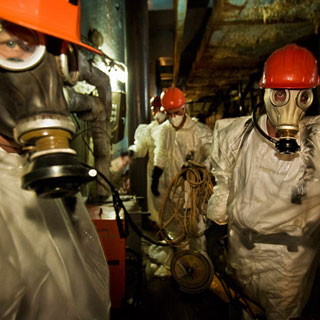 Workers wearing plastic suits and respirators for protection pause briefly on their way to drill holes for support rods inside the shaky concrete sarcophagus, a structure hastily built after the explosion to isolate the radioactive rubble of Reactor #4. Their job is to keep the deteriorating enclosure standing until a planned replacement can be built. It is hazardous work: radiation inside is so high that they constantly need to monitor their Geiger counters - and are allowed to work only one shift of 15 minutes per day. The Long Shadow of Chernobyl - Photographs © Gerd Ludwig/INSTITUTE[/caption]
AF: And you're making a statement, hopefully to expose the frightening dangers of nuclear accidents so that we can create a safer future for mankind.
GL: It is important to recognize that the people who have suffered so much in the zone know that my pictures are not going to change anything for them anymore. They are my real heroes, simply because they allow me to photograph them - with their broken hearts, in their meager homes, solely in the hope that tragedies like Chernobyl may be prevented in the future. They are the voiceless victims and they see me, and us as photographers, as a hope to share their suffering and make it known.
AF: How do you deal with knowing your objective and the politics that prevent you from achieving that objective? For example, when you're not allowed into an area that you know has great potential to tell this story and make significant, memorable photographs. How do you cope with the system telling you, "No, we are not going to let you in; we're not going to give you access to that." When the authorities don't want the world to know the true story, how do you deal with that frustration?
GL: There is no single solution or rule to deal with that. Sometimes it is persistence. Sometimes the backing of a magazine like National Geographic helps. Sometimes it's a cat-and-mouse game, where you feel authorities are telling you fu*k you and so your reaction is to fu*k them.
I mean, at times they are bluntly lying to your face. Then you may do things which you actually should not do, and overstep the limits.
Then there are other examples. I was shooting outside of the zone, in the south of Belarus, an area that was strongly contaminated by the fallout. I had decided to photograph in a kindergarten that received help through Chernobyl funding. I showed up in the morning and was greeted by some officials that were questioning me about what I was doing there. I was honest and I said, "Look, I am photographing here because I think some of the kids have deformities connected with the Chernobyl accident." And they said, "You won't find anything here."
My reply was this: "If you tell me, officially now, that this kindergarten does not have any children that could be victims of the Chernobyl accident, I will go back to our audience at National Geographic and report that your kindergarten doesn't need any more help from Chernobyl funding sources."
AF: Wow! That was clever of you.
GL: And you should have seen how fast they changed their minds!
AF: And you did it in a peaceful, non-threatening way, without getting aggressive
GL: Aggressive and threatening never works. No, that's not a good way.
AF: Do you think there's a moral code or compass for a photojournalist, not to approach subjects with your own agenda, or do you feel you should embrace your own agenda?
I mean, it's difficult to see anything positive about the Chernobyl accident. But do you feel you have an obligation to be neutral as a photojournalist? Or do you go in with your heart and slam your point of view through the choice of images you make?
GL: Oh my God! I don't walk around with an anti-nuclear power button on! I think I would describe myself as a "nuclear skeptic." But I let people make their own judgment when they look at my pictures. I let the situation speak for itself.
I think as photographers, we sometimes run the risk of putting ourselves too much into the center of attention by making pictures that scream, "Look what a great photographer I am!" For me the better picture is the one where people say, "Oh look at that! Isn't that painful," or, "Isn't that joyful."
We often go into situations with a pre-fabricated opinion about something. Then, we actually stop learning. We should go in curious and come out wiser. And so should the viewer.
Let me add this: one thing I believe is that a great photograph broadens the mind and touches the soul. An image should convey how we felt at the moment we pressed the shutter.
Q Did you have any heroes when you were younger? Were there any specific photographers whose work you felt compassionate about?
A Oh yes! I was impressed by the image from the Vietnam War by Eddie Adams of the Saigon General executing the VC soldier. I was also moved by the work in Vietnam by both Phillip Jones Griffiths and Nick Ut, who photographed the young, naked girl fleeing napalm and running towards camera.
[caption id="attachment_2039" align="alignleft" width="250"]
Workers wearing plastic suits and respirators for protection pause briefly on their way to drill holes for support rods inside the shaky concrete sarcophagus, a structure hastily built after the explosion to isolate the radioactive rubble of Reactor #4. Their job is to keep the deteriorating enclosure standing until a planned replacement can be built. It is hazardous work: radiation inside is so high that they constantly need to monitor their Geiger counters - and are allowed to work only one shift of 15 minutes per day. The Long Shadow of Chernobyl - Photographs © Gerd Ludwig/INSTITUTE[/caption]
AF: And you're making a statement, hopefully to expose the frightening dangers of nuclear accidents so that we can create a safer future for mankind.
GL: It is important to recognize that the people who have suffered so much in the zone know that my pictures are not going to change anything for them anymore. They are my real heroes, simply because they allow me to photograph them - with their broken hearts, in their meager homes, solely in the hope that tragedies like Chernobyl may be prevented in the future. They are the voiceless victims and they see me, and us as photographers, as a hope to share their suffering and make it known.
AF: How do you deal with knowing your objective and the politics that prevent you from achieving that objective? For example, when you're not allowed into an area that you know has great potential to tell this story and make significant, memorable photographs. How do you cope with the system telling you, "No, we are not going to let you in; we're not going to give you access to that." When the authorities don't want the world to know the true story, how do you deal with that frustration?
GL: There is no single solution or rule to deal with that. Sometimes it is persistence. Sometimes the backing of a magazine like National Geographic helps. Sometimes it's a cat-and-mouse game, where you feel authorities are telling you fu*k you and so your reaction is to fu*k them.
I mean, at times they are bluntly lying to your face. Then you may do things which you actually should not do, and overstep the limits.
Then there are other examples. I was shooting outside of the zone, in the south of Belarus, an area that was strongly contaminated by the fallout. I had decided to photograph in a kindergarten that received help through Chernobyl funding. I showed up in the morning and was greeted by some officials that were questioning me about what I was doing there. I was honest and I said, "Look, I am photographing here because I think some of the kids have deformities connected with the Chernobyl accident." And they said, "You won't find anything here."
My reply was this: "If you tell me, officially now, that this kindergarten does not have any children that could be victims of the Chernobyl accident, I will go back to our audience at National Geographic and report that your kindergarten doesn't need any more help from Chernobyl funding sources."
AF: Wow! That was clever of you.
GL: And you should have seen how fast they changed their minds!
AF: And you did it in a peaceful, non-threatening way, without getting aggressive
GL: Aggressive and threatening never works. No, that's not a good way.
AF: Do you think there's a moral code or compass for a photojournalist, not to approach subjects with your own agenda, or do you feel you should embrace your own agenda?
I mean, it's difficult to see anything positive about the Chernobyl accident. But do you feel you have an obligation to be neutral as a photojournalist? Or do you go in with your heart and slam your point of view through the choice of images you make?
GL: Oh my God! I don't walk around with an anti-nuclear power button on! I think I would describe myself as a "nuclear skeptic." But I let people make their own judgment when they look at my pictures. I let the situation speak for itself.
I think as photographers, we sometimes run the risk of putting ourselves too much into the center of attention by making pictures that scream, "Look what a great photographer I am!" For me the better picture is the one where people say, "Oh look at that! Isn't that painful," or, "Isn't that joyful."
We often go into situations with a pre-fabricated opinion about something. Then, we actually stop learning. We should go in curious and come out wiser. And so should the viewer.
Let me add this: one thing I believe is that a great photograph broadens the mind and touches the soul. An image should convey how we felt at the moment we pressed the shutter.
Q Did you have any heroes when you were younger? Were there any specific photographers whose work you felt compassionate about?
A Oh yes! I was impressed by the image from the Vietnam War by Eddie Adams of the Saigon General executing the VC soldier. I was also moved by the work in Vietnam by both Phillip Jones Griffiths and Nick Ut, who photographed the young, naked girl fleeing napalm and running towards camera.
[caption id="attachment_2039" align="alignleft" width="250"]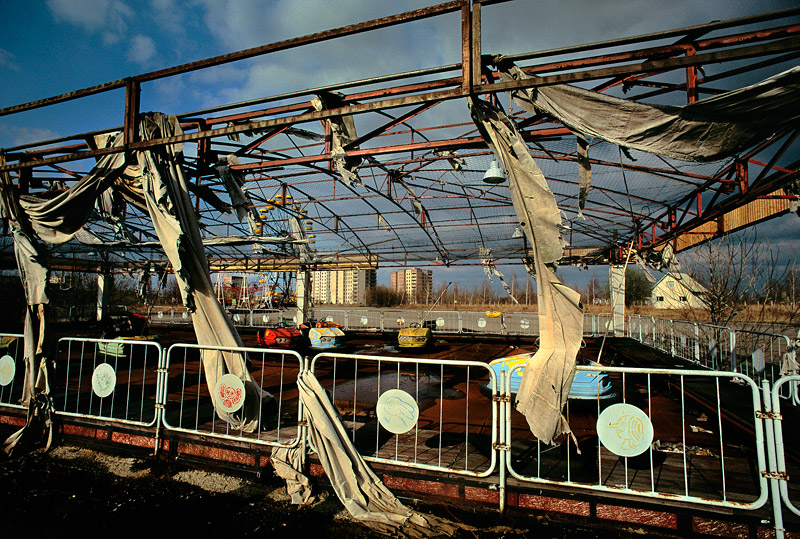 Wind blows through the desolate town of Pripyat. On April 26, 1986, this amusement park was being readied for the annual May Day celebrations when the Chernobyl nuclear reactor exploded less than two miles away and severely contaminated tens of thousands of square miles. The Long Shadow of Chernobyl - Photographs © Gerd Ludwig/INSTITUTE[/caption]
AF: That was a very controversial photograph. It had a huge influence on the American public's opinion of the Vietnam War. It helped bring an end to the conflict.
GL: I also liked the work of Ernst Haas, for example, which is very different from those photographers. Today, I enjoy looking at the intersection of Fine Art and Documentary Photography. I gain inspiration from a variety of people, my friends Lauren Greenfield and Douglas Kirkland, who are two very different photographers; my colleagues at National Geographic and at INSTITUTE and my students in workshops. I often enjoy looking at the way amateurs use photography.
When asked for my favorite photographers I once came up with a list of 52 names, my mother and my son amongst them - and they are total amateurs.
AF: What do you think the moral of the Chernobyl accident is?
GL: That as human beings we should not attempt to deal with technologies that are so horrific that they can cause these huge tragedies.
[caption id="attachment_2041" align="alignright" width="250"]
Wind blows through the desolate town of Pripyat. On April 26, 1986, this amusement park was being readied for the annual May Day celebrations when the Chernobyl nuclear reactor exploded less than two miles away and severely contaminated tens of thousands of square miles. The Long Shadow of Chernobyl - Photographs © Gerd Ludwig/INSTITUTE[/caption]
AF: That was a very controversial photograph. It had a huge influence on the American public's opinion of the Vietnam War. It helped bring an end to the conflict.
GL: I also liked the work of Ernst Haas, for example, which is very different from those photographers. Today, I enjoy looking at the intersection of Fine Art and Documentary Photography. I gain inspiration from a variety of people, my friends Lauren Greenfield and Douglas Kirkland, who are two very different photographers; my colleagues at National Geographic and at INSTITUTE and my students in workshops. I often enjoy looking at the way amateurs use photography.
When asked for my favorite photographers I once came up with a list of 52 names, my mother and my son amongst them - and they are total amateurs.
AF: What do you think the moral of the Chernobyl accident is?
GL: That as human beings we should not attempt to deal with technologies that are so horrific that they can cause these huge tragedies.
[caption id="attachment_2041" align="alignright" width="250"]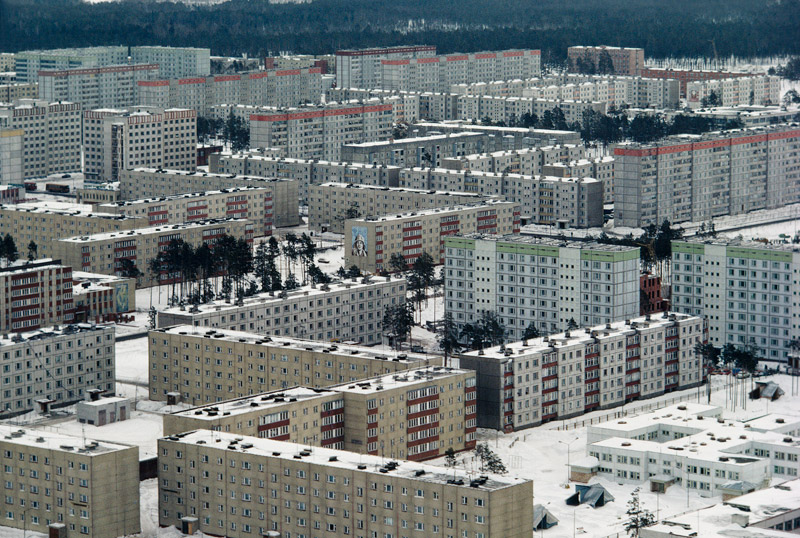 The nearby city of Pripyat once, once inhabited by 50,000 residents and brimming with life, now stands as a chilling ghost town. Built in 1970 for the scientists and the workers of the nearby Chernobyl Nuclear Power Plant, authorities did not warn residents of the accident, and issued the evacuation notice only 2 days after the explosion. The Long Shadow of Chernobyl - Photographs © Gerd Ludwig/INSTITUTE[/caption]
AF: In your opinion, do you think world leaders have learned the lesson?
GL: No, not much. In Chernobyl, Soviet officials told us that they were in total control, but they were not. Executives told us the same thing about the Gulf oil spill (the BP oil spill disaster in 2010). Nuclear power stations need a great deal of upkeep. If this is neglected, it can be very dangerous.
AF: Were you afraid of this assignment, personally? Afraid of the potential radiation you would be exposing yourself to?
GL: I was afraid, but my colleagues in war zones are afraid at times, as well. As photographers we do this, as I said before, to give a voice to otherwise voiceless victims. Plus, in comparison to the people who live on contaminated ground permanently, my risk is relatively small.
AF: When you said earlier that the authorities had requested that you remove your protective gear so as to not alarm the local people, what did you do? Did you remove it or keep it on?
GL: I have to admit there were situations were I did remove it to get access.
AF: Knowing you were going to expose yourself to harmful radiation?
GL: Potential radiation. You never know because you don't see the radiation, you don't smell it and you don't feel it.
AF: Are you going to glow if I turn the lights off?
GL: Well the nice thing is I don't need a strobe anymore. I use myself as a light source. (Laughs)
AF: Is there anyway of knowing how much radiation you have absorbed? Can they check your blood?
GL: No, not in any direct way, unless you have radioactive particles actually in your body.
AF: How were you able to shoot with a gas mask on? Did the protective gear inhibit your ability to shoot?
GL: I did not use a gas mask because you can't shoot with a gas mask. The workers would drill into the contaminated concrete, which created this contaminated dust. That was probably the most dangerous situation for me.
The reason they drill near the failed reactor is because the roof and the walls (which were built by robots after the accident) are in danger of collapsing. If that happens, we have the same catastrophe all over again, of the same magnitude. There is a plan to build a safe confinement, which will be positioned over the current encasement, and the current one will be dismantled, as it is structurally unsound.
AF: When is that supposed to occur?
GL: It was supposed to happen a few years ago. But at a cost of more than two billion dollars, it is not completed yet.
AF: Are they any closer to getting it done now?
GL: That is another reason I want to go back. The donor countries are slow to come up with the pledged funds.
AF: Why do you feel so strongly that you have stayed with this project? Why do you want to go back and revisit this and continue to expose yourself to a very dangerous situation?
GL: Chernobyl is not over; the contamination will be here for hundreds of years. But the traditional print media doesn't seem to be interested anymore. It happened twenty-five years ago. It's old news, they say. Yet, only a few people are aware of the possible dangers of that structure (the sarcophagus) collapsing. And an accident can happen again, in any nuclear power plant, anywhere in the world.
AF: You were able to go into the ghost town in 1995. How was that? That must have been surrealistic.
GL: It was very eerie.
[caption id="attachment_2047" align="alignright" width="175"]
The nearby city of Pripyat once, once inhabited by 50,000 residents and brimming with life, now stands as a chilling ghost town. Built in 1970 for the scientists and the workers of the nearby Chernobyl Nuclear Power Plant, authorities did not warn residents of the accident, and issued the evacuation notice only 2 days after the explosion. The Long Shadow of Chernobyl - Photographs © Gerd Ludwig/INSTITUTE[/caption]
AF: In your opinion, do you think world leaders have learned the lesson?
GL: No, not much. In Chernobyl, Soviet officials told us that they were in total control, but they were not. Executives told us the same thing about the Gulf oil spill (the BP oil spill disaster in 2010). Nuclear power stations need a great deal of upkeep. If this is neglected, it can be very dangerous.
AF: Were you afraid of this assignment, personally? Afraid of the potential radiation you would be exposing yourself to?
GL: I was afraid, but my colleagues in war zones are afraid at times, as well. As photographers we do this, as I said before, to give a voice to otherwise voiceless victims. Plus, in comparison to the people who live on contaminated ground permanently, my risk is relatively small.
AF: When you said earlier that the authorities had requested that you remove your protective gear so as to not alarm the local people, what did you do? Did you remove it or keep it on?
GL: I have to admit there were situations were I did remove it to get access.
AF: Knowing you were going to expose yourself to harmful radiation?
GL: Potential radiation. You never know because you don't see the radiation, you don't smell it and you don't feel it.
AF: Are you going to glow if I turn the lights off?
GL: Well the nice thing is I don't need a strobe anymore. I use myself as a light source. (Laughs)
AF: Is there anyway of knowing how much radiation you have absorbed? Can they check your blood?
GL: No, not in any direct way, unless you have radioactive particles actually in your body.
AF: How were you able to shoot with a gas mask on? Did the protective gear inhibit your ability to shoot?
GL: I did not use a gas mask because you can't shoot with a gas mask. The workers would drill into the contaminated concrete, which created this contaminated dust. That was probably the most dangerous situation for me.
The reason they drill near the failed reactor is because the roof and the walls (which were built by robots after the accident) are in danger of collapsing. If that happens, we have the same catastrophe all over again, of the same magnitude. There is a plan to build a safe confinement, which will be positioned over the current encasement, and the current one will be dismantled, as it is structurally unsound.
AF: When is that supposed to occur?
GL: It was supposed to happen a few years ago. But at a cost of more than two billion dollars, it is not completed yet.
AF: Are they any closer to getting it done now?
GL: That is another reason I want to go back. The donor countries are slow to come up with the pledged funds.
AF: Why do you feel so strongly that you have stayed with this project? Why do you want to go back and revisit this and continue to expose yourself to a very dangerous situation?
GL: Chernobyl is not over; the contamination will be here for hundreds of years. But the traditional print media doesn't seem to be interested anymore. It happened twenty-five years ago. It's old news, they say. Yet, only a few people are aware of the possible dangers of that structure (the sarcophagus) collapsing. And an accident can happen again, in any nuclear power plant, anywhere in the world.
AF: You were able to go into the ghost town in 1995. How was that? That must have been surrealistic.
GL: It was very eerie.
[caption id="attachment_2047" align="alignright" width="175"]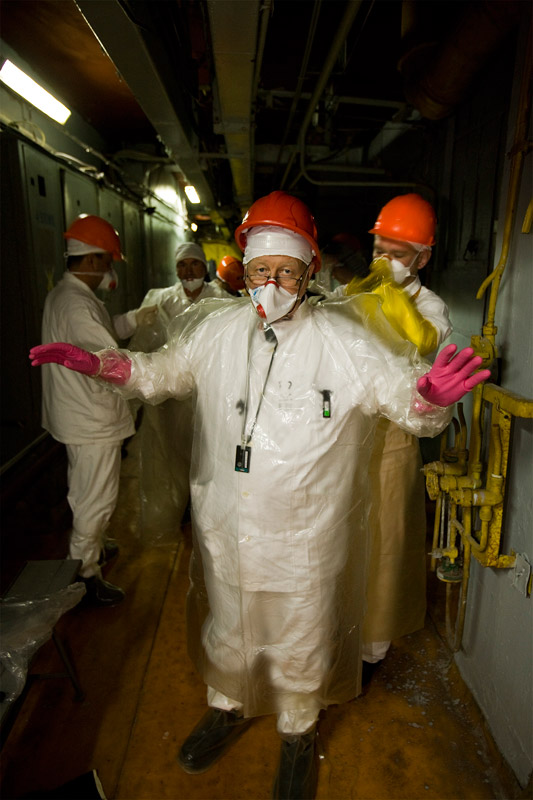 Photographer Gerd Ludwig gearing up for a 15-minute entry into the highly contaminated Reactor #4 - the maximum he and the shift workers are allowed to spend in a single day. The Long Shadow of Chernobyl - Photographs © Gerd Ludwig/INSTITUTE[/caption]
AF: In a certain way, it would set up some powerful, visual possibilities; the contaminated earth taking over the town with a haunting sense of "Why?" Were you shooting on instinct? Did you know where you wanted to go?
GL: It is difficult to convey the magnitude of the devastation. I am more interested in the personal stories of the survivors. I want to understand, so I photograph.
zone. Whereas five years ago I paid $60 for a car per day, they now want $600 for a 12-hour day.
AF: What if you drove your own car in?
GL: You can't. It's a fenced in area. You have to go through radiation control stations when entering or exiting. Even your clothing and body are tested for radiation particles when you leave. You are not allowed to drive in the zone, only official drivers are. There are no traffic signs and there are no maps.
AF: That parallels my vision of World War III. It's like a nuclear holocaust.
GL: It is.
AF: Lets talk about what you are hoping to accomplish now, going back to Chernobyl in 2011. I know you're hoping to raise money to help you to accomplish this trip and do what you've dedicated yourself to so passionately.
GL: I want to see what the situation on the ground is like today, what has changed in the last five years? ? Is there progress building the encasement? Did they manage to stabilize the roof with these huge pillars? And what about the returnees, how are they faring? Many of them had turned to alcoholism years ago, from living in total devastation and isolation.
AF: Are these the same returnees that you discussed and photographed earlier, the people who had chosen to move back into the contaminated zone?
GL: Yes. I also want to see the tests that are being done with mice and radioactivity inside the Chernobyl zone. I want to approach all the subjects that I didn't have the chance to approach in my earlier stays there.
AF: So in the end (if there is an end), what are you hoping to accomplish?
GL: I don't see this as the end. I want to continue this coverage into the future. I also want to counter the perception, propagated by a United Nations report that only 4,000 people would eventually succumb to cancer-related Chernobyl illnesses. When I thoroughly researched who contributed to that UN study, under the umbrella of so-called environmental organizations, they are the producers of nuclear power stations. For the record, serious environmental agencies have put that figure way over one hundred thousand now.
AF: That's frightening! It's like letting oil companies police themselves.
GL: It's important, in our need for energy that we don't allow someone to paint nuclear energy as "green" energy, especially when you see people who are on the ground crying out that something like this should never happen again.
AF: How can people help? What can they do to contribute and support your desire to go back and continue this historic project? What avenues are available to help you accomplish your goals?
GL: I have set up a kickstarter.com website. Kickstarter.com funds an incredible number of projects, including theatre, film, art, book-making, photography and graphic design. Last year they funded nearly 4,000 projects. Kickstarter.com is a fundraising tool for my project.
We know that conventional media is suffering financially. Here is a new tool where the public can support projects they would like to see with their pocketbook. This is very promising because young, internet-savvy people are supporting issue-driven, serious projects that have content. While many in the media are telling us that they have to turn to sensationalism and to celebrity reporting to keep the readership, on crowd-funding sites the public supports serious content-driven journalism with their donations.
AF: So if I were to make a contribution of $100 for your project through kickstarter.com, would you receive the full $100?
GL: They take five percent, which I think is very reasonable. Also, the people who contribute are recognized for their donations. The rewards differ, depending on the amount contributed and the nature of the project.
AF: Have you explored any other ways to raise money for the project? For example, approaching corporations to underwrite the majority of the costs?
GL: People and organizations have privately donated from $1 up to $2,500. I offer corporations an opportunity to have their company logo posted in a number of different places and on a variety of websites with links to their sites. When the work is exhibited every contributor will get exposure in the gallery where the photographs are on display. This will be worldwide, wherever the Chernobyl photographs are shown in the next four years.
AF: Again, just to be absolutely clear for our readers, they can visit the website www.kickstarter.com and then what?
GL: They would enter "Chernobyl" or my name, Gerd Ludwig, or go directly to www.kickstarter.com/projects/gerdludwig
My project page will then give you a whole history of Chernobyl, explaining why I am going back and tell visitors what they will receive in return for atheir contributions. If you make a $100 contribution, you receive a signed copy of my book "Broken Empire: After the fall of the USSR."
AF: Gerd, I'd like to express my deepest respect and admiration for what you are doing and tell you how personally moved I feel by your commitment to the Chernobyl project. Your photographs speak volumes about your compassion for the people affected and the consequences of this catastrophic event in human history.
Your photographs are beautiful to see and are extraordinarily powerful. I hope our readers will consider making a contribution to help you accomplish your goals on this meaningful endeavor. Thank you very much for taking the time to do this interview.
Photographer Gerd Ludwig gearing up for a 15-minute entry into the highly contaminated Reactor #4 - the maximum he and the shift workers are allowed to spend in a single day. The Long Shadow of Chernobyl - Photographs © Gerd Ludwig/INSTITUTE[/caption]
AF: In a certain way, it would set up some powerful, visual possibilities; the contaminated earth taking over the town with a haunting sense of "Why?" Were you shooting on instinct? Did you know where you wanted to go?
GL: It is difficult to convey the magnitude of the devastation. I am more interested in the personal stories of the survivors. I want to understand, so I photograph.
zone. Whereas five years ago I paid $60 for a car per day, they now want $600 for a 12-hour day.
AF: What if you drove your own car in?
GL: You can't. It's a fenced in area. You have to go through radiation control stations when entering or exiting. Even your clothing and body are tested for radiation particles when you leave. You are not allowed to drive in the zone, only official drivers are. There are no traffic signs and there are no maps.
AF: That parallels my vision of World War III. It's like a nuclear holocaust.
GL: It is.
AF: Lets talk about what you are hoping to accomplish now, going back to Chernobyl in 2011. I know you're hoping to raise money to help you to accomplish this trip and do what you've dedicated yourself to so passionately.
GL: I want to see what the situation on the ground is like today, what has changed in the last five years? ? Is there progress building the encasement? Did they manage to stabilize the roof with these huge pillars? And what about the returnees, how are they faring? Many of them had turned to alcoholism years ago, from living in total devastation and isolation.
AF: Are these the same returnees that you discussed and photographed earlier, the people who had chosen to move back into the contaminated zone?
GL: Yes. I also want to see the tests that are being done with mice and radioactivity inside the Chernobyl zone. I want to approach all the subjects that I didn't have the chance to approach in my earlier stays there.
AF: So in the end (if there is an end), what are you hoping to accomplish?
GL: I don't see this as the end. I want to continue this coverage into the future. I also want to counter the perception, propagated by a United Nations report that only 4,000 people would eventually succumb to cancer-related Chernobyl illnesses. When I thoroughly researched who contributed to that UN study, under the umbrella of so-called environmental organizations, they are the producers of nuclear power stations. For the record, serious environmental agencies have put that figure way over one hundred thousand now.
AF: That's frightening! It's like letting oil companies police themselves.
GL: It's important, in our need for energy that we don't allow someone to paint nuclear energy as "green" energy, especially when you see people who are on the ground crying out that something like this should never happen again.
AF: How can people help? What can they do to contribute and support your desire to go back and continue this historic project? What avenues are available to help you accomplish your goals?
GL: I have set up a kickstarter.com website. Kickstarter.com funds an incredible number of projects, including theatre, film, art, book-making, photography and graphic design. Last year they funded nearly 4,000 projects. Kickstarter.com is a fundraising tool for my project.
We know that conventional media is suffering financially. Here is a new tool where the public can support projects they would like to see with their pocketbook. This is very promising because young, internet-savvy people are supporting issue-driven, serious projects that have content. While many in the media are telling us that they have to turn to sensationalism and to celebrity reporting to keep the readership, on crowd-funding sites the public supports serious content-driven journalism with their donations.
AF: So if I were to make a contribution of $100 for your project through kickstarter.com, would you receive the full $100?
GL: They take five percent, which I think is very reasonable. Also, the people who contribute are recognized for their donations. The rewards differ, depending on the amount contributed and the nature of the project.
AF: Have you explored any other ways to raise money for the project? For example, approaching corporations to underwrite the majority of the costs?
GL: People and organizations have privately donated from $1 up to $2,500. I offer corporations an opportunity to have their company logo posted in a number of different places and on a variety of websites with links to their sites. When the work is exhibited every contributor will get exposure in the gallery where the photographs are on display. This will be worldwide, wherever the Chernobyl photographs are shown in the next four years.
AF: Again, just to be absolutely clear for our readers, they can visit the website www.kickstarter.com and then what?
GL: They would enter "Chernobyl" or my name, Gerd Ludwig, or go directly to www.kickstarter.com/projects/gerdludwig
My project page will then give you a whole history of Chernobyl, explaining why I am going back and tell visitors what they will receive in return for atheir contributions. If you make a $100 contribution, you receive a signed copy of my book "Broken Empire: After the fall of the USSR."
AF: Gerd, I'd like to express my deepest respect and admiration for what you are doing and tell you how personally moved I feel by your commitment to the Chernobyl project. Your photographs speak volumes about your compassion for the people affected and the consequences of this catastrophic event in human history.
Your photographs are beautiful to see and are extraordinarily powerful. I hope our readers will consider making a contribution to help you accomplish your goals on this meaningful endeavor. Thank you very much for taking the time to do this interview.





